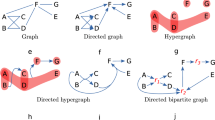Abstract
We investigated the problem of constructing the maximum consensus tree from rooted triples. We showed the NP-hardness of the problem and developed exact and heuristic algorithms. The exact algorithm is based on the dynamic programming strategy and runs in O((m + n 2)3n) time and O(2n) space. The heuristic algorithms run in polynomial time and their performances are tested and shown by comparing with the optimal solutions. In the tests, the worst and average relative error ratios are 1.200 and 1.072 respectively. We also implemented the two heuristic algorithms proposed by Gasieniec et al. The experimental result shows that our heuristic algorithm is better than theirs in most of the tests.
Similar content being viewed by others
References
A.V. Aho, Y. Sagiv, T.G. Szymanski, and J.D. Ullman, “Inferring a tree from lowest common ancestors with an application to the optimization of relational expressions,” SIAM Journal on Computing, vol. 10,no. 3, pp. 405–421, 1981.
L.R. Ford and D.R. Fulkerson, Flows in Networks, Princeton University Press: Princeton, New Jersey, 1962.
M.R. Garey and D.S. Johnson, Computers and Intractability: A Guide to the Theory of NP-Completeness, W.H. Freeman and Company: San Fransisco, 1979.
L. Gasieniec, J. Jansson, A. Lingas, and A. Östlin, “On the complexity of constructing evolutionary trees,” Journal of Combinatorial Optimization, vol. 3, pp. 183–197, 1999.
M.R. Henzinger, V. King, and T. Warnow, “Constructing a tree from homeomorphic subtrees, with applications to computational biology,” in Proc. of the 7th ACM-SIAM SODA, 1996, pp. 333–340.
J. Jansson, “On the complexity of inferring rooted evolutionary trees,” in Proceedings of the Brazilian Symposium on Graph, Algorithms, and Combinatorics (GRACO01), Fortaleza, Electronic Notes in Discrete Mathematics, vol. 7, Elsevier, 2001, pp. 121–125.
D.R. Karger, “Minimum cuts in near-linear time,” in Proc. of the 28th ACM STOC, 1996, pp. 56–63.
R.M. Karp, “Reducibility among combinatorial problems,” in Complexity of Computer Computations, R.E. Miller and J.W. Thatcher (Eds.), Plenum Press: New York, 1972, pp. 85–103.
C.L. Liu, Elements of Discrete Mathematics, 2nd edn. McGraw-Hill: New York, 1998.
M.P. Ng and N.C. Wormald, “Reconstruction of rooted trees from subtrees,” Discrete Applied Mathematics, vol. 69, pp. 19–31, 1996.
M. Steel, “The complexity of reconstructing trees from qualitative characters and subtrees,” Journal of Classification, vol. 9, pp. 91–116, 1992.
Author information
Authors and Affiliations
Rights and permissions
About this article
Cite this article
Wu, B.Y. Constructing the Maximum Consensus Tree from Rooted Triples. Journal of Combinatorial Optimization 8, 29–39 (2004). https://doi.org/10.1023/B:JOCO.0000021936.04215.68
Issue Date:
DOI: https://doi.org/10.1023/B:JOCO.0000021936.04215.68




